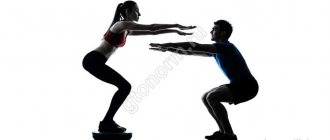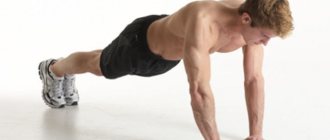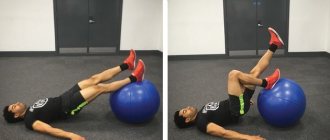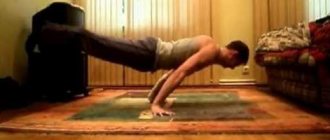© byswat — stock.adobe.com
Share:
All types of push-ups belong to pressing exercises, so breathing during push-ups is a fundamental point, without which it is impossible to perform this exercise correctly. Today we will figure out how to breathe correctly when doing push-ups and parallel bars and why it is so important.
Diaphragmatic breathing
One of the mistakes that prevents you from practicing and getting excellent results is fast, shallow breathing.
To check if you are breathing correctly, do a short test. Stand up straight, place one palm on your chest and the other on your stomach, and calmly take a few breaths in and out. Under which palm do you feel the movement? If your stomach rises, you breathe deeply, using all your lungs; if your chest, you breathe shallowly. Deep breathing is also called diaphragmatic breathing.
The diaphragm is a muscle that separates the chest and abdominal cavities and serves to expand the lungs. It accounts for 60 to 80% of the work on ventilation of the lungs.
As a child, everyone breathes deeply. Due to sedentary work, stress, uncomfortable clothing, breathing changes with age and becomes shallow. During such breathing, only the upper part of the lungs is filled with air. Since there is less air flow, breathing becomes faster, increasing pressure on the neck and shoulders, which are already stressed in people with sedentary work.
The diaphragm, on the contrary, becomes weaker, due to which sufficient intra-abdominal pressure is not created, poor posture is formed - the center of the abdomen falls inward, bringing the lower ribs and pelvis closer together.
In addition, when you breathe quickly and shallowly, you force your body to work harder to get the same amount of oxygen as when you breathe calmly and deeply. This reduces the efficiency of your movements - you spend more energy, although this is not required.
Therefore, it is worth working on your breathing at least while doing the exercises. Try to breathe deeply and evenly. When you inhale, your stomach should inflate. Yes, you will have to concentrate more on your body, but for the sake of good posture, relieving tension in the muscles of the neck and shoulders, and more economical movement, it is worth doing.
To get ready for strength training with proper breathing, pay attention to how you breathe during the warm-up. Try to perform all exercises with rhythmic deep breathing. This way you will quickly learn to breathe correctly.
How to learn to breathe correctly - have you ever asked yourself this question? Anyone who has ever attended a yoga class has learned about the enormous possibilities that such a simple and natural process as breathing gives us. Taking a long, slow breath allows your entire body to relax. Indeed, such breathing calms, helps control your emotions, reduces blood pressure, develops stress resistance and fills you with energy.
Since breathing is a natural process, we do not think about how it happens, what mechanisms are involved in it. We just breathe and that’s it. This means that we don’t try to improve our breathing technique and easily end up with incorrect breathing. But if you practice a little and practice proper breathing techniques, you will improve your health, learn to relax, and activate your mental activity. In addition, proper breathing can relieve headaches, bloating, dizziness and give strength, since the body is better supplied with oxygen. In addition, by breathing correctly, including the work of the diaphragm in the breathing process, all internal organs are massaged, and people experience constipation, inflammation and pain in the abdominal cavity. Diaphragmatic breathing has a positive effect on the functioning of the heart, lungs, stomach, liver, gallbladder, and intestines. What is correct breathing and why should we strive for it?
Breath test
First, check how you breathe. Normal quiet breathing occurs through the diaphragm. Place your hand on your navel: when you inhale, your belly should protrude forward. If this does not happen, it means that you are using the upper part of the chest instead of the diaphragm to breathe, then when you inhale, the navel may “press in”, like after a run, when you have to restore your breathing for a while.
Then, in a calm state, count how long you can go without inhaling. This time should be approximately 30 seconds. And for those who have breathing problems, this time is less than 5 seconds.
Another indicator of proper breathing is the number of breaths. It's good if you take 12 to 15 breaths per minute, but it's wrong if you take 20 breaths or more. Frequent sighs and yawning are another indicator of improper breathing. You may feel like you are short of breath and unable to get enough air into your lungs. If you slouch while sitting at the computer or wear tight clothes, you also have breathing problems.
How to learn to breathe correctly?
Through short training, you can develop and strengthen the skill of proper breathing, and the correct breathing technique will help you with this.
Diaphragmatic breathing - exercise
So, a relaxing exercise for proper diaphragmatic breathing. Sit comfortably, choose any comfortable position in a place convenient for you. Breathe slowly and rhythmically through your nose and lower chest. This will help you use your diaphragm to breathe. In order for you to do the diaphragmatic breathing exercise correctly, you can place one hand on your chest and the other on your navel. As you inhale, your stomach inflates and, accordingly, the hand lying on your navel rises up; as you exhale, it goes down. At the same time, the chest remains motionless - the hand on the chest, respectively, too. Reduce the number of breaths you take – aim for just 8 breaths per minute. At first it may seem a little difficult to you, but with daily training, you will succeed. When you can do this without straining, try to breathe like this all the time, check from time to time whether you are now breathing correctly. In other words, diaphragmatic breathing should become a habit and occur involuntarily. You will only occasionally monitor the correctness of its implementation.
In addition to performing the relaxing breathing exercise “diaphragmatic breathing,” you need to pay attention to the following:
- Find time to relax It is very important to set aside at least 20 minutes during the day for absolute relaxation - this will help you gain control of your breathing. There are many ways to relax, choose one that does not provoke you to inhale too often and deeply.
- Pay attention to your posture Maintaining correct posture is the path to proper breathing. If you hunch or slouch, you strain and compress the diaphragm. Strengthen your back muscles, try to walk straight and sit straight - this will allow the diaphragm to work more efficiently.
- Breathe through your nose Breathe through your nose, not your mouth. Breathing through the nose warms the air to the desired temperature and moisturizes it and, as a result, allows you to breathe more relaxed. Breathing through your nose rather than your mouth is an important factor in learning how to breathe properly. If you have a runny nose and a stuffy nose, then treat it in time, do not make the disease worse, so that there are no complications such as sinusitis.
- Avoid stimulants If you're used to snacking on high-carbohydrate foods, your blood sugar levels will fluctuate more, which will speed up your breathing. Stimulants like caffeine also cause the same reaction. Carbon dioxide affects blood vessels, and when they contract, glucose metabolism, and therefore blood sugar fluctuations, increases.
- Don't take deep breaths After training or physical activity, sometimes you feel the urge to relax and take a deep breath. Try to overcome it. Slow, measured breaths, rather than long, deep ones, are what you want.
- Try to yawn less
If you often have the urge to yawn, stop yourself. Try to replace yawning with swallowing to avoid releasing excess air. Frequent sore throat, as well as an irritating cough, can also be an indicator of improper breathing.
British scientists say that despite the common misconception that poor breathing prevents us from consuming oxygen, we actually lose carbon dioxide. If you breathe quickly and often, then with each breath the level of carbon dioxide in the blood decreases, and its deficiency disrupts the natural acid-base balance in the body and interferes with the effective use of oxygen. It turns out to be a vicious circle - the blood vessels and airways narrow, therefore, the brain's respiratory center receives a signal that it is necessary to inhale oxygen, so you are forced to constantly breathe frequently.
It is necessary to break this circle in order to take the path of recovery and well-being. Master this simple technique of proper breathing and you will be able to control your thoughts and feelings at the right time. You will learn not only to relax well, but also, along with proper breathing, more oxygen will enter your body, which means that all systems and organs will be better supplied with it, which will lead to the overall health of the whole body.
Hygienist A.I. Zinovich
Exhale for effort, inhale for relaxation
This is the most popular breathing advice you hear in and out of the gym: inhale when you do the easy part of the exercise, exhale when you push it.
Strong and safe movement is only possible with a rigid spine, which transmits force from large muscle groups. The spine is strengthened by tensing the core muscles - the rectus and oblique abdominal muscles, the pelvic floor muscles, and the back. During inhalation, it is impossible to tense the abs and other core muscles well, which means it is difficult to provide the necessary rigidity to the spine.
When exhaling, on the contrary, it is quite easy to tense your core muscles. Breathing affects them reflexively, through the nervous system. The muscles tighten, fixing the spine and helping to develop maximum strength. That is why the effort must be performed while exhaling.
If you pay attention to your breathing during heavy exercise, you may notice a brief cessation of breathing at the point of maximum effort. This is quite natural. Brief breath-holding is used by experienced powerlifters and weightlifters to lift heavy weights. This breathing technique is called the Valsalva maneuver, but it should be used very carefully.
Is the Valsalva maneuver dangerous?
The Valsalva maneuver is a procedure that creates high pressure in the middle ear, chest and abdominal cavities. It is used in otolaryngology to test the patency of the Eustachian tubes and in cardiology to identify heart pathologies. This maneuver is also used in powerlifting and weightlifting and helps athletes lift heavy weights.
The Valsalva maneuver used in strength sports is as follows: a person takes a deep breath (about 75% of the maximum possible), and then, at the moment of maximum effort, holds his breath for several seconds and tries to exhale air through a closed glottis. Breathing is held throughout the repetition, exhalation occurs after completion.
The Valsalva maneuver increases pressure in the chest. Through the diaphragm, it is transmitted into the abdominal cavity, which creates good support for the back and helps resist forces that tend to move the spine. As a result, the athlete can lift more weight and the risk of injury is reduced.
Effects of the Valsalva maneuver on the body
However, the Valsalva maneuver is often criticized because it increases blood pressure that is already high during strength training, which can lead to a heart attack.
Opinions differ on this issue. Dr. Jonathon Sullivan, a professor in the department of emergency medicine at Wayne State University, believes that only those who have pre-existing cardiovascular problems should be concerned about heart attacks when using the Valsalva maneuver.
In another study, Effects of Weightlifting and Breathing Technique on Blood Pressure and Heart Rate. Using this technique to raise a one-time max has been found to cause only minor changes in blood pressure. The Valsalva maneuver is only suitable for lifting really heavy weights for low repetitions.
Using the Valsalva maneuver for multiple repetitions with light weights can cause dangerous increases in blood pressure, rupture of blood vessels in the eyes and face, headaches, temporary blurred vision, and may cause fainting or cerebrospinal fluid leaks.
The last problem was described in the article Don't Hold Your Breath. Vishal Goyal and Malathi Srinivasan, MDs, of the Department of Medicine at the University of California.
A 50-year-old patient complained of headaches in the projection of the nose, continuous cough and constant unilateral nasal discharge. As a result of the tests, doctors discovered a leak of cerebrospinal fluid and damage to the nasal ethmoid bone. It turned out that the patient performed chest presses every day with a weight of 90–136 kilograms. At the same time, he held his breath during the bench press.
Doctors suggested that the patient's problems arose precisely because of the Valsalva maneuver. The training increased blood pressure and destroyed the meninges, which caused meningocele and cerebrospinal fluid rhinorrhea.
The Valsalva maneuver does help lift heavy weights, but it should not be used if:
- you are a beginner who does not have a set technique and a trainer who can monitor the correct execution of the Valsalva maneuver;
- you prefer exercises with light weights and high repetitions;
- you had problems with the cardiovascular system;
- you have had problems with intracranial pressure.
Strengthening the core and continuous breathing
For moderate loads, it is worth using continuous breathing without delay - exhale for effort, inhale for relaxation.
Start exhaling a little earlier, a moment before maximum effort. This way you can do more.
Breathing should be smooth and rhythmic. Don't stop at the extremes. Immediately after inhalation, exhale without short delays.
To ensure maximum shell rigidity, try using the anchoring method. This term was first used by Dr. Stuart McGill, a lumbar spine injury and rehabilitation specialist. Bracing is the activation of the entire core muscles to create a rigid midsection, provide core stability and reduce the risk of injury.
Before lifting weights, imagine that you are about to get hit in the stomach. Tighten your abdominal and back muscles. This will create a rigid corset that you need to hold throughout the entire exercise. At the same time, breathe continuously, exhaling with maximum effort and further strengthening your core.
There is another theory about breathing during strength training. Dr. Stuart McGill and Dr. Mel Stiff believe that proper exercise technique will automatically force the body to breathe correctly, without any need for your supervision.
But this is only true for ideal technology. If you can't boast of one, work on your breathing as well as your technique.
What happens to the body during push-ups?
Whatever type of push-ups you perform, there is a load on all the muscles of the shoulder girdle. The main part of it falls on the pectoral muscles, anterior deltoids and triceps. The abdominal muscles, spinal extensors and buttocks are in a state of static tension.
When lowering the body down, the muscles stretch, and when lifting, they contract. In this case, it is important to keep your back straight, not to round the cervical spine, not to raise your buttocks above the level of your lower back and, of course, to monitor your breathing rate. Only then will you achieve the correct technique for performing push-ups, which will help you:
- Quickly tone almost all muscle groups of the upper body.
- Perform more repetitions.
- Get faster results than when doing it with incorrect technique and breathing.
- Reduce the risk of injury.
Results
- Try to develop diaphragmatic breathing. Breathe like this during the warm-up to get used to it and tune in.
- Use the Valsalva maneuver only for a few repetitions at maximum weight.
- For high-repetition exercises, use continuous, smooth breathing, inhaling for the easy part of the exercise and exhaling for the maximum effort.
- Along with continuous breathing, use bracing—tension of your core muscles to stabilize your core during exercise.
If you have any tips for breathing during strength training, please leave a comment.
How to breathe correctly when doing push-ups?
Take a lying position, begin to bend your elbows and lower yourself down. At this time, take a breath. It should be smooth, it is advisable to stretch it for the entire duration of the negative phase of the movement. It is recommended to inhale through the nose. The exhalation should be sharper; do it at the moment of lifting. At this point, it will be more convenient for you to exhale through your mouth .
Similarly with dips - inhale through your nose when lowering and exhale through your mouth when rising to the starting position.
If you pause for a second at the top or bottom point, you don’t need to breathe during it, start inhaling strictly as you lower.











